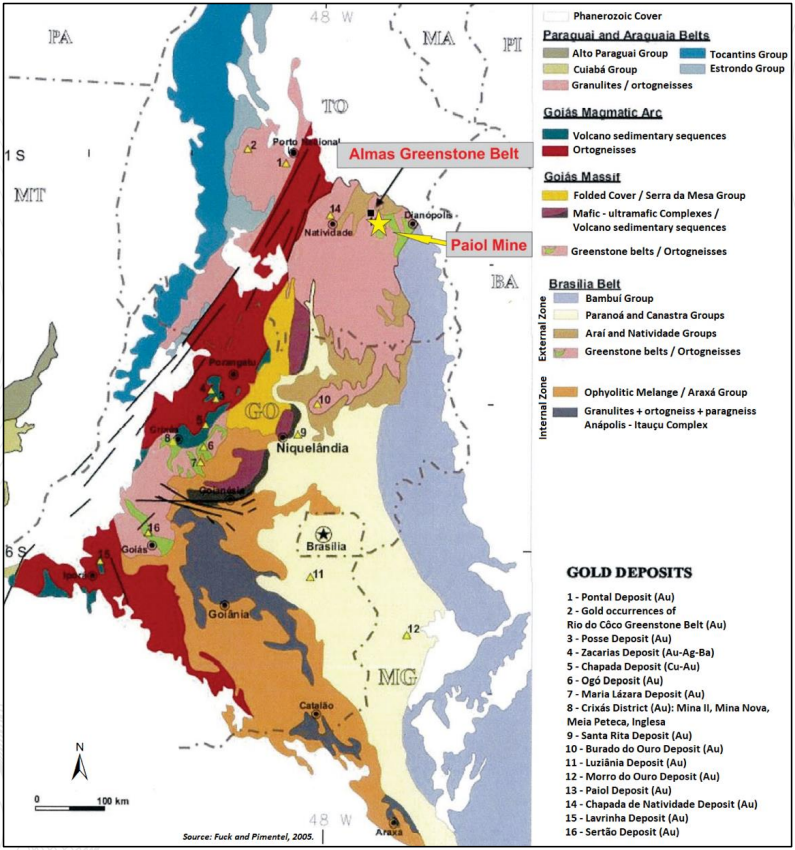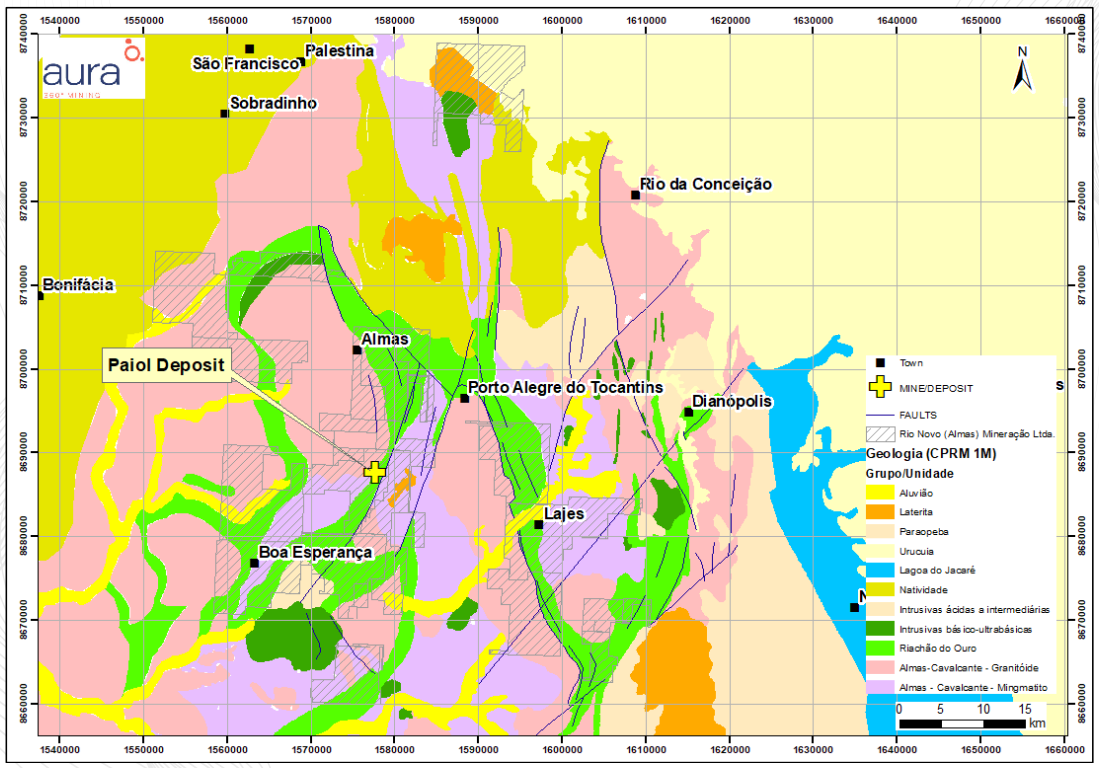Tocantins Structural Province
Tags: amphibolite ankerite argillic alteration conglomerate dolomite granite granite gneiss green schists greenstone belt marble ophiolite phyllite pyrrhotite quartzite schist sericite tourmaline
Description:
The Tocantins Structural Province (TSP), located in the central region of Brazil, constitutes a system of Brazilian orogens, characterized by folding and thrusting belts called the Brasília, Paraguay and Araguaia Belts, resulting from the convergence and collision of three continental blocks: Amazonian Craton, to the West; Cráton São Francisco, to the East; and Cráton Paranapanema, to the Southwest, covered by the rocks of the Paraná Basin, this one with its limits inferred through gravimetric data. The foundation of the province is composed of Archaean and Paleoproterozoic terrains reactivated during the Brazilian Cycle (Delgado et al., 2003). In the final stages of the Brazilian Cycle, the gravitational collapse, exhumation and / or extrusion of the orogens, which occurred up to the Upper Ordovician have been related as a transition stage between conditions of active convergent tectonics to conditions of intraplate stability, with the beginning of the Paleozoic basins.
These phanerozoic coverings, in almost all Paraná, Parnaíba, Bananal and Pantanal Mato-Grossense basins, hide large parts of this system.
The TSP is compartmentalized in the Cráton São Francisco for small exposures of the basement and the extensive sedimentary coverings, Brasília Belt, built on the west side of the craton, divided into Zones Internal and External, Goiás Massif and Goiás Magmatic Arch.
The Brasília Belt is a well-preserved orogenic belt, consisting of a thick set of passive-edge sedimentary rocks associated with volcanic rocks, a mixture of ophiolitic, calc-alkaline volcanic arch-type rocks and intrusive S-type granites. The degree of metamorphism increases to the West, moving from low-grade non-metamorphic and metamorphic rocks, on the São Francisco Craton border to the East, to high-temperature amphibolite facies and ultra-high-temperature granulites in the metamorphic nucleus, decreasing again for amphibolite and green schist facies in the rocks of Goiás Magmatic Arch.
The tectonic zoning of the Brasília Belt is marked by a foreland transition from the São Francisco Craton to the East, External and Internal allochthonous zones formed in an old passive Neoproterozoic margin of the paleocontinent São Francisco-Congo to the West, for the exotic terrains of the Goiás Massif and the Goiás Magmatic Arch.
In the central part of the Tocantins Province the following Precambrian domains are recognized: Crixás – Goiás Archean Terrain, interpreted as a small allochthonous continental block; Paleoproterozoic sialic base, represented by orthogneisses and metavolcanosedimentary sequences, in the region of Almas – Dianópolis; the Anápolis – Itauçu High-grade Complex; Paleo-Mesoproterozoic Mafic Ultramafic Bedded Complexes (Barro Alto, Niquelândia, Canabrava) and associated metavolcanosedimentary sequences; and Goiás Magmatic Arch, of the Neoproterozoic.
The External Zone of the Brasília Belt is composed of Mesoproterozoic and Neoproterozoic metasedimentary units represented by the Araí and Natividade Groups, Paranoá and Canastra Groups, as well as portions of the Archean-Paleoproterozoic basement that show rejuvenation due to the Brazilian tectonics.
The Northern and Southern portions of the outer zone of the Brasília Belt represent two contrasting styles of proximal continental passive margins. In its Northern part, between Alto Paraíso de Goiás and Natividade / TO, it consists of a large Paleoproterozoic crustal block, partially covered by a gently folded rift sequence of the Arai Group metasedimentary rocks (1.77 Ga and younger). This block is limited to the East for thrust faults that places it over the rocks of Bambuí group. To the South of Alto Paraíso de Goiás, the Araí Group is inconsistently covered by the Paranoá Group, which is also pushed over the Bambuí Group to the East.
The Natividade Group is represented by quartzites, conglomeratic quartzites, phyllites, schist quartz, marbles and the Araí Group, composed of a set of metamorphic and metavolcanic rocks, of low metamorphic degree, superimposed on the Aurumina Suite and the Ticunzal Formation, constitutes a succession deposited in an intracontinental rift basin, whose evolution started before 1.77 Ga in the Paleoproterozoic.
The Paranoá Group corresponds to a psammite-pelite-carbonated succession deposited under platform conditions. Its deposition is interpreted as occurring in the Mesoproterozoic (1,542 to 1,042 Ma). Its age is corroborated by its stratigraphic position (it occurs on sediments from the Araí Group post-rift phase and under the Bambuí Group pelites and carbonates), by the presence of conical stromatolites (conophyton ) and isotopic data.
The Canastra Group is considered a lateral equivalent of the Paranoá Group, with more marked metamorphism, and occurring in the south-central part of the Brasília Belt.
The Internal Zone includes allochthonous units of the Araxá Group, as well as portions of the basement heavily involved in the Brazilian tectonics (Goiás Massif, with remnants of greenstone belts). There are also granulitic mafic-ultramafic complexes and Proterozoic volcano-sedimentary sequences.
The Pre-Cambrian lands, which constitute the Tocantins Structural Province, are characterized by folded and metamorphized supracrustal belts, exposed along the edges of the Amazonian Cratons (Paraguay and Araguaia Belts) and São Francisco (Brasília and Uruaçu Belts). Amid the folded belts, there is the so-called Goiás Massif, a massif of crystalline rocks of varied nature and age, whose geotectonic significance is still poorly understood due to the scarcity of geochronological data, and geophysical and structural information.
The Massif of Goiás is considered an allochthonous microplate, added to the Western margin of the Brasília Belt during the last stages of evolution of the Neoproterozoic orogenesis. It consists of a set of typical TTG granite-gneiss complexes and narrow bands of greenstone-belt sequences. The granite-gneiss lands are comprised of orthogneisses that, in the Northern part of the land, comprise the Tapir, Caiamar, Moquém and Hidrolina and, in the South, the Caiçara and Uvá complexes.
Regional geologic map of the northern sector of the Tocantins Province in Central Brazil (after Fuck etal., 1994).
There are two metamorphic events, one, M1, related to Dn, restricted to the greenstones and M2 related to shear zones Dn+1, which affects all units of the Almas-Dianópolis Terrane. Regional metamorphic paragenesis M1 varies from amphibolite to greenschist facies and the main paragenesis in metabasalts is amphibolite + plagioclase ± chlorite ± epidote. M2 paragenesis is characterized by amphibolite + albite + epidote ± white mica ± chlorite, occurring in the greenstones, granite-gneiss complexes and basic-ultrabasic intrusions. The amphibolite composition of M1 paragenesis varies from ferric actinolite to tshermakitic hornblende, while the plagioclase varies from albite to andesine.
The orogenic gold deposits are characterized by the predominance of quartz veins, containing sulfides (≤3-5%), mainly Fe sulfides and carbonate minerals (≤5-15%). The veins may contain albite, white mica, chlorite, tourmaline in the greenschist domains; or amphibole, diopside, biotite-phlogopite, tourmaline and garnet in the amphibolite facies. The veins evolve a continuous system with an extension of approximately 1-2 km and little change in mineralogy or intensity of mineralization.
Hydrothermal alteration presents more pronounced lateral variation than vertical variation in the plane of mineralization. The hydrothermal mineral assembly and the intensity of mineralization varies according to the type of embedding rock and crustal level of alteration. Regionally, the presence of calcite, dolomite, ankerite, pyrite, chlorite, sericite and fuchsite is recognized in the greenschists facies, and calcite, pyrrhotite, Ca amphiboles, diopside, coarse, biotite and feldspar in higher metamorphic degrees. Sulfidation is more intense in banded iron formations and carbonation is dominant in mafic and ultramafic embedding rocks. Significant enrichment of SiO2 in the mineralized zones is evidenced by the presence of large amounts of quartz veins.
Always associated with shear zones (Dn+1), the mineralization is essentially hosted in the granite-gneiss complexes and banded iron and greenstone amphibolite formation. In all occurrences, gold is hosted by segregations and / or quartz veins bordered by hydrothermal alteration zones, mainly sericitization and argilization in gneissic granite, chloritization, sericitization and carbonatization in amphibolite and carbonation, sulfidation and tourmalinization in banded iron formation. The main deposits are Vira-Saia, in granite-gneiss and Córrego Paiol, in amphibolite.
Tocantins Province Tectonostratigraphic Map
Deposits
-
Name: Paiol
Phase: Exploration
Mine Type: None
Intro:
The Paiol deposit is in the south-central region of Tocantins State, Brazil. The deposit area lies south of Almas (population 7,000), a small town approximately 300 km southeast of Palmas, the Tocantins State Capitol and 45 km west of Dianópolis, a regional commercial center. The Almas town site is accessed by State Highways TO-010, TO-070 and TO-050 from the state capital of Palmas, via Porto Nacional to Natividade – a trip of approximately four hours by car. Palmas, the capital city of Tocantins State (population 306,000) has all the major facilities for industrial support as well as State governmental agencies. Palmas supports a regional airport with scheduled commercial service departing several times a day to Brasilia and São Paulo. The principal commercial center in the Almas region is Dianópolis, 45 km east of the Almas town site. There are commercial flight options from Barreiras airport, with flights to Brasília, Belo Horizonte and Salvador. Barreiras is about four hours by car to Almas. Barreiras (population of 156,000) and Luiz Eduardo Magalhães (population of 90,000), located east of Almas, with distances of 280 and 190 km respectively., On the BR-242 and TO-040 highways, are cities with good infrastructure, service companies, commerce and industries. From the city of Almas, the three target areas may be reached by all-weather gravel roads, well maintained by the local government. The 17 km distance from Almas to the Paiol mine is traversed by light vehicle in approximately 20 minutes. Almas may also be reached by chartered aircraft as the local government maintains a small gravel airstrip south of the town site. At present, there is no rail service into the Almas area.
Mineralizations
No mineralizations available.
Placers
No placers available.

